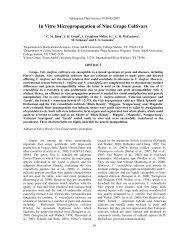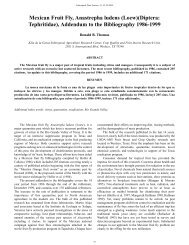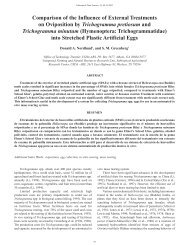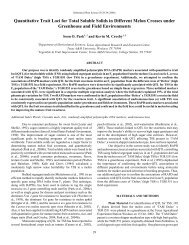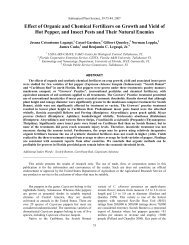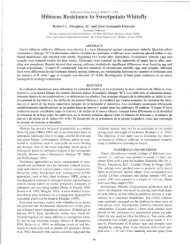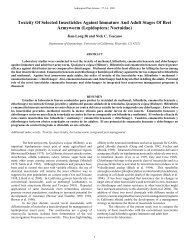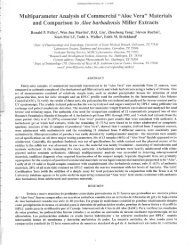Subtropical Plant Sci. J. 52:1-7. - Subtropical Plant Science Society
Subtropical Plant Sci. J. 52:1-7. - Subtropical Plant Science Society
Subtropical Plant Sci. J. 52:1-7. - Subtropical Plant Science Society
You also want an ePaper? Increase the reach of your titles
YUMPU automatically turns print PDFs into web optimized ePapers that Google loves.
<strong>Subtropical</strong> <strong>Plant</strong> <strong>Sci</strong>ence, <strong>52</strong>: 1-<strong>7.</strong>2000<br />
marker was different from the previously reported<br />
(MUSKFOM I/MUSKFOM II) (Wechter et al., 1998) based on<br />
the BLAST sequence analysis and database comparative<br />
searches. More importantly, the newly developed SCAR<br />
marker (PI596B1/ PI596B2) was more conserved or prevalent<br />
across diverse melon cultigens than MUSKFOM<br />
I/MUSKFOM II. The former was able to amplify the expected<br />
1.4 kb SCAR fragment from 23 out of 36 (64 %) resistant<br />
cultigens tested, whereas the latter amplified the expected 1.5<br />
kb fragment from only a few genotypes (Wechter et al., 1998).<br />
The fact that the same size of DNA fragment amplified from<br />
different template sources across populations / species does not<br />
necessarily mean that they are exactly the same (Thormann et<br />
al., 1994). The homology of these SCAR fragments was<br />
confirmed by Southern hybridization analysis. For the<br />
preliminary screening with SCAR markers, Southern<br />
hybridization may not be necessary. Nevertheless, a complete<br />
optimized protocol for rapid and sensitive application of<br />
Southern hybridization by using fluorescein labeling and<br />
detection system was reported (Zheng and Wolff, 1999).<br />
Although the SCAR marker, like the RAPD marker, is<br />
dominant, making it less useful in scoring segregating<br />
populations, it could be very effective for screening large<br />
populations, such as germplasm collections, in the early stages<br />
of a breeding program because of its simplicity, rapidity, and<br />
cost-efficiency.<br />
While bulked segregant analysis is an efficient and reliable<br />
way for identifying putative DNA markers segregating with a<br />
target trait, mapping the F2 population is needed to confirm the<br />
linkage of the marker to the disease phenotype. Although the<br />
SCAR results were scored in and supported by diverse<br />
cultigens, mapping the marker in an F2 population is<br />
indispensable for determining the genetic distance between the<br />
marker and the resistance gene.<br />
ACKNOWLEDGEMENTS<br />
Authors thank Dr. M. Pitrat (INRA, Station de Génétique<br />
et d’Amélioration des Fruits et Légumes, BP 94, 84143<br />
Montfavet cedex, France) for sending some of the resistant<br />
cultigens, and Dr. R. A. Dean for sharing some DNA samples<br />
of F2 individuals from crosses between Ananas Yokneam x<br />
MR-1. We also thank Kay E. Harding for her help in planting<br />
melon seedlings in the greenhouse for DNA extractions. We<br />
deeply appreciate Drs. K. Crosby, S. Legaspi, and B.<br />
Wiedenfeld for help in revision of the manuscript.<br />
REFERENCES<br />
Baudracco-Arnas, S. 1995. A simple and inexpensive method<br />
for DNA extraction from Cucumis melo L. Cucurbit<br />
Genetic Cooperative Report 18:50-51.<br />
Baudracco-Arnas, S and M. Pitrat. 1996. A genetic map of<br />
melon (Cucumis melo L.) with RFLP, RAPD, Isozyme,<br />
disease resistance and morphological markers. Theor.<br />
Appl. Genet. 93:57-64.<br />
Benoit, F. 1974. The Fusarium problem in melon growing in<br />
Belgium and the relative value of certain rootstocks.<br />
Tuinbouwerichten (Belgium) 38: 16-20.<br />
Chupp, C. 1930a. Fusarium wilt of muskmelon. <strong>Plant</strong> Dis.<br />
Rep. 14:160.<br />
Chupp, C. 1930b. Fusarium wilt of muskmelon. <strong>Plant</strong> Dis.<br />
Rep. 81 (Suppl.):116.<br />
Gu, W.K., N.F. Weeden, J. Yu, and D.H. Wallace. 1995. Largescale,<br />
cost-effective screening of PCR products in markerassisted<br />
selection applications. Theor. Appl. Genet.<br />
91:465-470.<br />
Haley, S.D., P.N. Miklas, J.R. Stavely, J. Byrum, J.D. Kelly.<br />
1993. Identification of RAPD markers linked to a major<br />
rust resistance gene block in common bean. Theor. Appl.<br />
Genet. 86:505-512.<br />
Jarvis. P., C. Lister, V. Szaba, C. Dean. 1994. Integration of<br />
CAPs markers into the RFLP map generated using<br />
recombination inbred lines of Arabidopsis thaliana. <strong>Plant</strong><br />
Mol. Biol. 24:685-68<strong>7.</strong><br />
Koetsier, P.A., J. Schorr, and W. Doerfler. 1993. A rapid<br />
optimized protocol for downward alkaline southern<br />
blotting of DNA. Biotechniques 15:260-262.<br />
Konieczyn, A. and F.A. Ausubel. 1993. A procedure for<br />
mapping Arabidopsis mutations using co-dominant<br />
ecotype-specific PCR-based markers. <strong>Plant</strong> J. 4:403-410.<br />
Leach, J.G. 1933. A destructive Fusarium wilt of muskmelon.<br />
Phytopathol. 23:554-556.<br />
Leach, J.G. and T. M. Currence. 1938. Fusarium wilt of<br />
muskmelons in Minnesota. Minnesota Agric. Exp. Station<br />
Tech. Bull. 129:32.<br />
Leary, J.V. and W.D. Wilbur. 1976. Identification of the races<br />
of Fusarium oxysporum f. sp. melonis causing wilt of<br />
muskmelon in California. Phytopahol. 66: 15-16.<br />
Martyn, R.D., L.W. Banes, and J. Amador. 198<strong>7.</strong> Fusarium wilt<br />
(F. oxysporum f. sp. melonis race 0) of muskmelon in<br />
Texas. <strong>Plant</strong> Dis. 70:233-236.<br />
Mayer, M.S., A. Tullu, C.J. Simon, W.J. Kaiser, J.M. Kraft, F.J<br />
Muehlbauer. 199<strong>7.</strong> Development of a DNA Marker for<br />
Fusarium wilt resistance in Chickpea. Crop <strong>Sci</strong>ence<br />
37:16251629.<br />
Michelmore, R.W., I. Paran, and R.V. Kesseli. 1991.<br />
Identification of markers linked to disease-resistance<br />
genes by bulked segregant analysis: A rapid method to<br />
detect markers in specific genomic regions by using<br />
segregating populations. Proc. Natl. Acad. <strong>Sci</strong>. USA<br />
88:9828-9832.<br />
Miklas, P.N., L. Afando, J.D. Kelly. 1996. Recombinationfacilitated<br />
RAPD marker-assisted selection for disease<br />
resistance in common bean. Crop <strong>Sci</strong>ence 36:8690.<br />
Paran, I., R. Kesseli, R.W. Michelmore. 1991. Identification of<br />
restriction fragment length polymorphism and random<br />
amplified polymorphic DNA markers linked to downy<br />
mildew resistance genes in lettuce, using near-isogenic<br />
lines. Genome 34:1021-102<strong>7.</strong><br />
Paran, I. and R.W. Michelmore. 1993. Development of reliable<br />
PCR-based markers linked to downy mildew resistance<br />
genes in lettuce. Theor. Appl. Genet. 85:985-993.<br />
Pitrat, M., G. Risser, F. Bertrand, D. Blancard, and H. Lecoq.<br />
1996. Evaluation of a melon collection for disease<br />
resistances. in Cucurbits toward 2000. VIth EUCARPIA<br />
6



